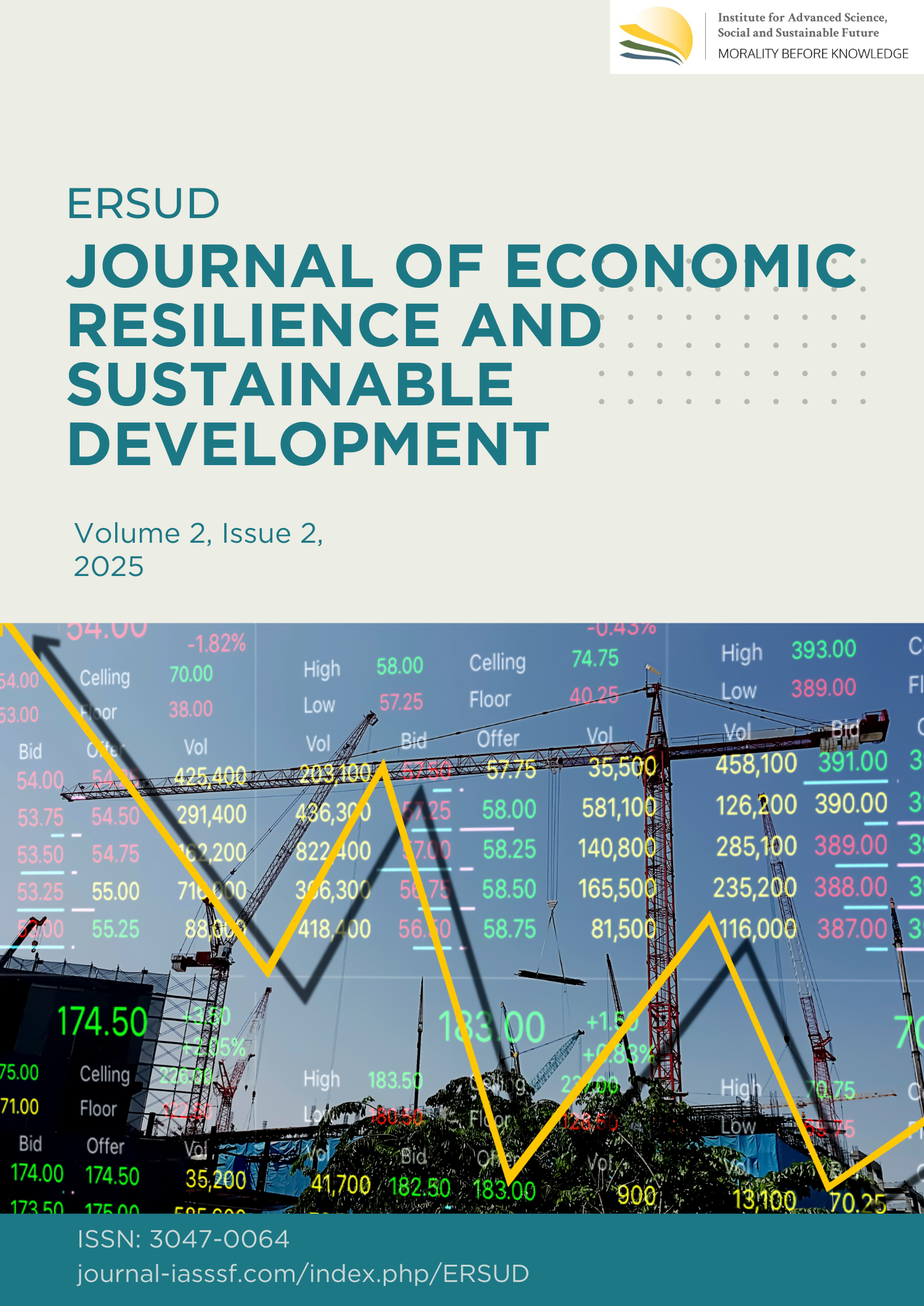The effect of foreign direct investment on economic growth in Indonesia: A case study using secondary data for 1995-2023
DOI:
https://doi.org/10.61511/ersud.v2i1.2025.1400Keywords:
economic growth, Foreign Investment, inflationAbstract
Background: Foreign Direct Investment (FDI) is one of the key instruments for driving economic growth in most countries, including Indonesia. FDI refers to a type of investment in which foreign entities directly invest capital into an economic entity in the host country. Foreign Direct Investment has become an essential source of external financing for Indonesia and serves as one of the primary funding sources. Therefore, this study aims to comprehensively analyze the impact of FDI on Indonesia’s economic growth over the period 1995–2023. Methods: This study employs a quantitative research approach with multiple linear regression analysis. This model is chosen because it allows for the measurement of the simultaneous influence of multiple independent variables on a single dependent variable, namely economic growth. The study utilizes processed secondary data supplemented with time series data, including Gross Domestic Product (GDP) growth, foreign investment, inflation rate, exchange rate, government expenditure, and poverty levels. Findings: The findings indicate that FDI positively and significantly affects Indonesia’s economic growth. FDI enhances production capacity, increases efficiency, and facilitates technology transfer, contributing to national productivity. Additionally, a stable exchange rate and controlled inflation support economic development. However, the exchange rate negatively affects economic growth, suggesting that fluctuations may hinder investment and economic activities. Meanwhile, inflation is found to have no significant impact on GDP growth, possibly due to economic stability, political events, or government interventions during the study period. Conclusion: Based on the research findings, it can be concluded that FDI plays a significant role in driving economic growth in Indonesia. However, exchange rate fluctuations pose a challenge that should be managed to ensure economic stability. Novelty/Originality of this article: The novelty of this research lies in its comprehensive time-series analysis covering nearly three decades, providing insights into the long-term relationship between FDI and economic growth in Indonesia.
References
Aflakhah, Z., Jajang, J., & Br. Sb., A. T. (2020). Kajian metode ordinary least square dan robust estimasi M pada model regresi linier sederhana yang memuat outlier. Jurnal Ilmiah Matematika dan Pendidikan Matematika, 11(1), 21. https://doi.org/10.20884/1.jmp.2020.12.1.1934
Amelia, A. (2023). Analisis dampak inflasi dan investasi syariah pada pertumbuhan ekonomi Indonesia. SINOMIKA Journal: Publikasi Ilmiah Bidang Ekonomi dan Akuntansi, 2(1), 1–10. https://doi.org/10.54443/sinomika.v2i1.905
Azzaky, H. R. (2022). Pengaruh aliran modal, sistem keuangan, inflasi, dan partisipasi tenaga kerja terhadap pertumbuhan ekonomi di 12 negara kawasan Asia Pasifik pada tahun 2009-2019. Journal of Development Economic and Social Studies, 1(1), 161–174. https://doi.org/10.21776/jdess.2022.01.1.15
Badan Pusat Statistik. (2023). Laporan perekonomian Indonesia. BPS.
Borensztein, E., Gregorio, J. D., & Lee, J. W. (1998). How does foreign direct investment affect economic growth? Journal of International Economics, 45(1), 115–135. https://doi.org/10.1016/S0022-1996(97)00033-0
Destiani, E., Anggrya, Y., Aida, N., Moniyana, R., Pembangunan, E., Ekonomi dan Bisnis, F., & Lampung, U. (2023). Pengaruh foreign direct investment (FDI) dan ekspor terhadap pertumbuhan ekonomi di Indonesia tahun 1990-2021. Convergence: The Journal of Economic Development, 5(1), 1–13. https://doi.org/10.33369/convergencejep.v5i1.28471
Djamaris, A. (2024). Panduan lengkap: Cara melaporkan hasil regresi linier berganda. Universitas Bakrie.
Fakhrizal, F., Mulyadi, M., & Alfaris, S. (2023). Pengaruh investasi asing langsung, tenaga kerja dan pengeluaran pemerintah terhadap pertumbuhan ekonomi di Indonesia. JIM: Jurnal Ilmiah Mahasiswa, 5(April), 1–20. https://doi.org/10.32505/jim.v5i1.5893
Gandhi, E. A., Pasaribu, E., Ekaputri, R. A., & Febriani, R. E. (2022). Investasi asing langsung dan pertumbuhan ekonomi: Perbandingan empiris Indonesia dan Singapura. Ecoplan, 5(2), 159–170. https://doi.org/10.20527/ecoplan.v5i2.563
Ghozali, I. (2016). Aplikasi analisis multivariate dengan program IBM SPSS 23 (Edisi 8). Badan Penerbit Universitas Diponegoro. https://accounting.binus.ac.id/2021/08/12/memahami-uji-t-dalam-regresi-linear/
Hidayat, D. N., & Yusuf, A. A. (2024). Dampak investasi asing, inflasi, indeks pemberdayaan gender, dan indeks persepsi korupsi pada pertumbuhan ekonomi Indonesia. Jurnal Ekonomi dan Riset Pembangunan Sosial, 4(2), 263–276. https://doi.org/10.53088/jerps.v4i2.1113
Ikatan Bankir Indonesia. (2013). Memahami bisnis bank. Gramedia Pustaka Utama.
Jamil, P. C., & Hayati, R. (2021). Pasar modal dan penanaman modal asing di Indonesia. Journal of Economic, Business and Accounting (COSTING), 4(2), 477–484. https://doi.org/10.31539/costing.v4i2.1990
Kuncoro, M. (2022). Ekonomi pembangunan: Teori, masalah, dan kebijakan. UGM Press.
Marthen, A. E., Usmany, E., W., Kasman, H., Setiawan, R., & Windreis, C. (2024). Peran investasi asing langsung dalam pembangunan ekonomi negara berkembang: Sebuah sintesis literatur. Jurnal Review Pendidikan dan Pengajaran, 7(2), 3227–3233. https://doi.org/10.31004/jrpp.v7i2.26343
Meilaniwati, H., & Tannia, T. (2021). Analisis pengaruh penanaman modal asing (PMA), penanaman modal dalam negeri (PMDN), trade openness (TO), dan inflasi terhadap pertumbuhan ekonomi di ASEAN-5 tahun 2009-2018. Business Management Journal, 17(1), 89. https://doi.org/10.30813/bmj.v17i1.2582
Nadzir, M., & Setyaningrum, K. A. (2023). Investasi asing dan investasi dalam negeri: Pengaruhnya pada pertumbuhan ekonomi di Indonesia. JIMAT (Jurnal Ilmiah Mahasiswa Akuntansi) Undiksha, 14(2), 317–328. https://doi.org/10.23887/jimat.v14i02.54408
Pratama, R. A., & Soebagiyo, D. (2022). Analisis pengaruh jumlah uang beredar, inflasi, investasi, dan nilai tukar rupiah terhadap pertumbuhan ekonomi di Indonesia. SEIKO: Journal of Economic & Management, 4(3), 344–355. https://doi.org/10.37531/sejaman.v4i3.2767
Romadhon, F. A., & Nawawi, Z. M. (2024). Economic reviews journal. Economic Reviews Journal, 3(1), 96–108. https://doi.org/10.56709/mrj.v3i4.402
Sadli, M., Mallongi, S., & Zakaria, J. (2022). Analisis pengaruh belanja negara dan investasi terhadap pertumbuhan ekonomi Indonesia. Journal of Accounting Finance (JAF), 3(2), 30–45. https://doi.org/10.52103/jaf.v3i2.931
Shem, D. N., & Prasetyia, F. (2023). Analisis pengaruh penanaman modal dalam negeri dan penanaman modal asing terhadap pertumbuhan ekonomi inklusif di Indonesia. Journal of Development Economic and Social Studies, 2(1), 26–37. https://doi.org/10.21776/jdess.2023.02.1.3
Susanto. (2017). Pengaruh inflasi, tingkat suku bunga, dan nilai tukar terhadap pertumbuhan ekonomi Indonesia. Jurnal Ekonomi Bisnis Indonesia (JEBI), 12(1), 52–68. https://doi.org/10.36310/jebi.v12i1.27
Triyola, F., & Matondang, K. A. (2023). Analisis pengaruh inflasi pada pertumbuhan perekonomian Indonesia. IJM: Indonesian Journal of Multidisciplinary, 1(1). Retrieved from https://journal.csspublishing.com/index.php/ijm/article/view/113
University, B. (2023). Memahami R Square (koefisien determinasi) dalam penelitian ilmiah. Binus University.
Widarjono, A. (2016). Ekonometrika: Teori dan aplikasi untuk ekonomi dan bisnis. Yogyakarta: UPP STIM YKPN.
Wau, M., Wati, L., & Fau, J. F. (2022). Teori pertumbuhan ekonomi (kajian konseptual dan empirik). Eureka Media Aksara.
Downloads
Published
Issue
Section
Citation Check
License
Copyright (c) 2025 Heni Engelica Engelica, Annisa Retno Wulansari, Faridlotun Muthoharoh, Fayi Faizah Azzahra, Nurul Istiqomah, Selvia Cantikasari

This work is licensed under a Creative Commons Attribution 4.0 International License.















